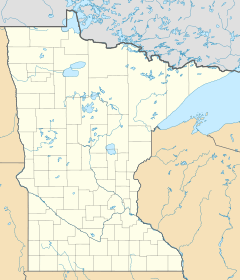Sand River (Stony River tributary) facts for kids
Quick facts for kids Sand River |
|
|---|---|
| Country | United States |
| State | Minnesota |
| County | Lake County |
| Physical characteristics | |
| Main source | Greenwood Lake West 47°33′54″N 91°41′55″W / 47.5649156°N 91.6984933°W |
| River mouth | Slate Lake East 47°39′47″N 91°35′51″W / 47.66306°N 91.59750°W |
The Sand River is a small river located in the state of Minnesota, United States. It is a natural waterway that flows into the Stony River. Rivers like the Sand River are important parts of the natural world. They help shape the land and provide homes for many plants and animals.
Contents
Discover the Sand River
The Sand River is a good example of a smaller river in a larger river system. It might not be as famous as big rivers like the Mississippi, but it plays a key role in its local area. Think of it as a smaller branch of a big tree.
Where is the Sand River Located?
The Sand River is found in Lake County, Minnesota. Minnesota is a state known for its many lakes and rivers. It's often called the "Land of 10,000 Lakes." The Sand River is one of the many waterways that make up this beautiful landscape.
- Source: The river starts near a place called Greenwood Lake West. This is where the river begins its journey.
- Mouth: The Sand River ends when it flows into the Stony River. This meeting point is near Slate Lake East. When one river flows into another, the smaller river is called a tributary.
Why are Rivers Important?
Rivers, even small ones like the Sand River, are super important for many reasons. They do a lot for nature and for people.
- Water Supply: Rivers provide fresh water. This water is used by animals, plants, and sometimes even people for drinking.
- Habitats: Rivers are homes for many different creatures. Fish, insects, birds, and mammals all depend on rivers for food and shelter.
- Shaping the Land: Over many years, rivers help to carve out valleys and canyons. They carry away soil and rocks, changing the landscape.
- Transportation: Historically, rivers were like natural highways. People used them to travel and move goods. Even today, some large rivers are used for shipping.
- Recreation: People enjoy rivers for fun activities. This can include fishing, canoeing, kayaking, and simply enjoying nature.
The River's Journey
Every river has a journey, from where it starts to where it ends. The Sand River's journey is relatively short compared to some of the world's longest rivers. It flows through natural areas, likely surrounded by forests and wetlands typical of Minnesota. These areas are important for keeping the river clean and healthy.
- Starting Point: The river begins as small streams or springs. These tiny trickles of water join together to form the main river.
- Flowing Downstream: As the river flows, it picks up speed and gathers more water from other small streams.
- Joining a Larger River: Finally, the Sand River reaches its destination, flowing into the Stony River. The Stony River then continues its own journey as part of an even bigger river system.
Understanding rivers like the Sand River helps us appreciate the natural world around us. They are vital for life and play a big part in the environment.


